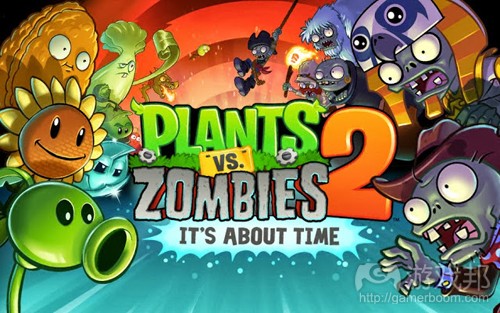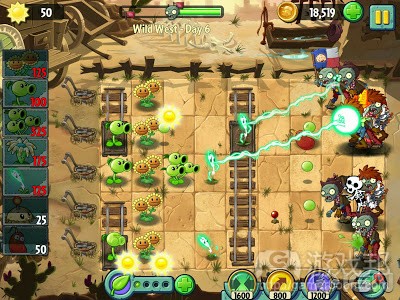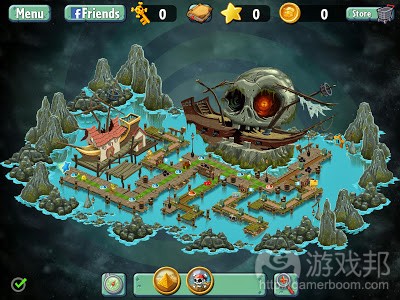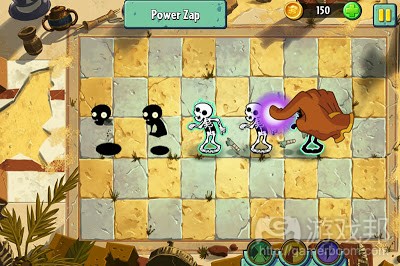《植物大战僵尸2》为何无法跻身收益榜单之首?
作者:Michail Katkoff
个人认为《植物大战僵尸2》(以下简单称PVZ2)是款很棒的游戏。它保护了原版游戏所有的长处,并添加了新内容,以及地图和手势操作升级等新功能。最大的变化在于,它从付费游戏转向免费模式。
现在看来,该游戏转为免费模式是令其直接跻身iPhone和iPad收益榜单前20名的明智之举。这对于一款原先是付费版本的游戏来说是个不错的成绩,但进入前20名却可能并不是PopCap和EA所希望的结果。从EA的推广力度来看,该游戏没有进入前10名足以说明它的盈利情况并不妙。
我将在本文解释这款游戏为何没有进入iOS榜单收益前10名的4个主要原因。
1.不适应不同的玩法环境
人们通常会窝在家里玩手机游戏,他们此时拥有足够的时间,也较少受到其他突发事件的干扰。但除了在家之外,人们还会在上下班途中,公司和上厕所时玩手机游戏。不同的游戏情境有不同的时长,因此游戏所需要的不同程度的集中注意力也是一个重要因素。
作为游戏开发者你有两种选择。要不就设计适用于不同环境的游戏,以便玩家任何时候都有空用游戏打发时间。或者你也可以选择忽略不同的游戏环境,寄希望于玩家回家或进入洗手间时会开启你的游戏——当然还可以认为他们不会再玩自己过去玩了一整天的其他游戏。
(每个关卡都要耗费很多时间,需要玩家投入100%的注意力,这令PVZ2成了一款不适合处于经常分心的环境中所玩的游戏)
PVZ2就是忽视不同游戏环境的一个典型。首先,其所有的游戏回合都很长,大概要4分钟才能玩完一个关卡。相比《Candy Crush Saga》一分钟就能结束一条命的的玩法,这确实是太冗长了。其次,玩PVZ2需要绝对的精神集中,手指速度要够快才行。一不留神你就可能损失一颗太阳花。如果再不专心你就可能输掉整个关卡。总之,它并非那种你可以在上下班坐车途中,随时可能被打断的情况下可以玩的游戏。
但不要误解我的意思。我并不是说手机游戏要获得成功就必定要适用于所有游戏环境。许多游戏是通过创造不同的游戏回合来解决这个问题。例如在《Clash of Clans》中,玩家就需要高度的精神集中,一个闪失就可能失败。但玩家可以轻松应对搜集资源、训练军队以及与同盟聊天等情况。
2.缺乏社交玩法
与真人玩游戏,尤其是玩家已经认识的人,是游戏留存和盈利的关键。想象一下《Hay Day》玩家如果不能同其他玩家进行交易会怎么样?如果没有进展地图显示你的好友进展,以及他们在每个关卡中的情况,《Candy Crush Saga》还会那么好玩吗?
(尽管植入了Facebook Connect以及漂亮的进程地图,PVZ2中还是没有什么社交元素)
PVZ2鼓励玩家登录Facebook帐号玩游戏。PVZ2还会呈现玩家在地图中的进展。尽管这两个元素创造了游戏经济中的社交玩法,PVZ2仍然不能显示玩家的Facebook好友在地图上的情况,也不能提供基于关卡的积分排行榜。这一点很糟糕。
盈利性是由竞争推出的。基于关卡的免费游戏中的竞争则是由基于地图的进程模式和基于关卡的积分排行榜推动。如果这两者都没有,那么PVZ2在盈利性上就要吃亏了。
3.缺乏难度
容易上手,持续奖励以及每一关都能让玩家获得成就感,已经成为免费游戏约定俗成的规则了。像《FarmVille》、《Sims Social》和《Hay Day》等游戏就成功遵循了这一惯例。它们能够确保新玩家喜欢其游戏,也能够确保玩家不会“输掉”游戏。简单地说,这些游戏并不重视玩家的技巧。玩家的成功和进步与其投入游戏的时间相关。
在一定程度上讲,免费游戏的准则确实管用,但也要符合其游戏题材才行。模拟游戏适合这种做法,但免费益智和街机游戏则应区别对待。正如我们所知,在《Candy Crush Saga》、《Jelly Splash》或《愤怒的小鸟》中的某个关卡输掉,只会让我们越挫越勇。而通过这些关卡则会给人奇妙的胜利感。
不幸的是PVZ2却极为简单。玩家不费吹灰之力就可以通过关卡,令游戏丧失挑战性并变得乏味。我认识的多数人不再玩PVZ2的一个原因就是因为游戏缺乏挑战性。但他们却没有人退出《Candy Crush Saga》,即便自己有一周的时间都被卡个某个关卡中。
缺乏难度不但会影响用户留存率,还会危及IAP收益。PVZ2会为花钱的玩家提供加速道具,以便他们使用易消耗的超级威力清除关卡障碍。但要创造这些加速道具的需求,就要让玩家意识到他们如果不使用这些道具,就可能输掉游戏。缺乏挑战性会导致加速道具需求降低,这会就导致收益停滞不前。
4.无核心循环
在我看来,免费游戏的真正要点在于核心循环。核心循环单次回合的机制。限制机制正是任何成功核心循环的一个关键部分。
核心循环并不复杂。例如,《Candy Crush Saga》就只有Lives这种单一的限制机制。玩家在每回合时都会自然消耗Lives,将其耗尽后,玩家可以选择等待,或者向Facebook好友求助,或者花钱真钱填补Lives。
(《Candy Crush Saga》的核心循环非常简单和有效)
《Hay Day》的核心循环则非常复杂。在《Hay Day》中你一开始是种植庄稼,这会激活该循环的首个计时器。在庄稼成熟时,玩家就可以收割并使用它们去生产其他资源,从而激活其他玩家所需生产物品的计时器。
在每个生产阶段,玩家都可以选择通过P2P市场或者向NPC出售自己所制造的商品。
从核心循环角度长看,《Hay Day》的目标是将时间转化为游戏内置货币,但随着玩家投次更多时间完善产品,其制造产品所需的时间也在不断下降。事实上,极为高效的玩家会通过长期投入游戏,出售基本物品而非精心制作但却极为耗时的产品而赚到更多钱。虽然从玩家角度来看,花大量时间生产南瓜饼,并以每个100 coins的价钱出售,总比节省时间,以每袋15 coins的价钱出售小麦,更能够令其获得良好的感觉。
PVZ2并没有限制机制,因此也不存在核心循环。游戏的理想核心循环应该类似于《Candy Crush Saga》,即每回合都有能量限制。我认为基于能量的核心循环不能够增加游戏的盈利性,因为这种做法创造了能量的持续需求,增加了升级需求——当重新开始一个关卡更费成本时,不要输掉关卡就会成为玩家的关注重点。
《植物大战僵尸2》实际上是一款“无价”付费游戏
PVZ2说到底其实是款没有价格标签的付费游戏。当然,它提供了IAP,但免费模式的定义并不仅局限于此。如果没有限制机制,就不会有核心循环,而这样就会导致游戏难以产生IAP需求。IAP需求太低就会导致游戏缺乏社交整合,而后者正是创造玩家之间的合作与竞争的必备元素。
(免费模式并不仅局限于增加IAP)
将付费游戏转化为免费游戏非常困难,许多人担心这种转变会令玩家不快。但在我看来,这是一种完全错误的想法,因为它的立足点就是免费模式不受玩家欢迎。但如果玩家真的不喜欢免费游戏,那么应用商店收益榜单就绝不会是免费游戏唱主角的情况了。(本文为游戏邦/gamerboom.com编译,拒绝任何不保留版权的转载,如需转载请联系:游戏邦)
Why Plants vs. Zombies 2 Can’t Make It To the Top
by Michail Katkoff
The following blog post, unless otherwise noted, was written by a member of Gamasutra’s community.
The thoughts and opinions expressed are those of the writer and not Gamasutra or its parent company.
Personally I think that Plants vs. Zombies 2 (PvZ2) is a great game. The game has kept all the good from the first episode and spiced it up with new content as well as features like map and gesture operated powerups. The biggest change of the sequel though is that it went from paid to free. And as you know, this blog is all about game mechanic.
In hindsight it seems that dropping the price tag was a smart choose as PvZ2 broke briefly into top20 crossing on iPhone and iPad. This is a good result from a essentially paid game, but top20 isn’t probably something PopCap and EA was expecting. Given the promotion power EA possesses, not braking top10 grossing is an evidence that PvZ2 monetizes portly.
In this post I’ll present the 4 main reasons why PvZ2 is unlikely to ever reach top10 grossing on iOS.
1. Unsuitable for Different Play Environments
People play mobile games in the comfort of their home, where they have plenty of time and limited amount of sudden and unexpected distractions. But apart from home, games are also played while commuting, at work and in the solitary of the bathroom (source: Tech Crunch). Because of different play environment session length and the amount of concentration game demands can be seen as a crucial factor.
As a developer you have two choices. Either design your game so that it suits different environments thus enabling players to enjoy it throughout their days and fill up their free moments with a few minutes of fun. Or you can ignore this fact of different play environments and just hope that players will launch you game when they get back home or into the bathroom – assuming of course that they won’t continue playing that other game they have been playing throughout the day.
Each level takes a lot of time and demands 100% concentration making PvZ2 unsuitable for quick game sessions in places with a lot of distractions.
PvZ2 is a good example of ignoring different play environments. First of all the session are always long. It takes around 4 minutes to give one level a go. That’s long comparing to a minute it takes to loose a life in Candy Crush Saga. Secondly playing PvZ2 demands absolute concentration, finger speed and both of your thumbs. Look away and you lost a Sun. Keep looking away and you’ve failed a level. It’s just not the kind of a game you want to play while commuting or when there’s a risk of distraction.
Now don’t get me wrong. I’m not saying that in order to succeed, mobile game has to be similarly playable in all environments. Many titles avoid this problem simply by creating different kind of play sessions. For example in Clash of Clans attacking requires a lot of concentration as a missed tap results easily in a defeat. But collecting resource building, training troops as well as chatting with the clan can be done easily on the go.
2. Lack of Social Gameplay
Playing a game with real people, preferably someone players know, is essential for retention and monetization. Imagine Hay Day without the ability to trade goods with other players? How about Candy Crush Saga without the progression map showing how far your friends have progressed and how they have faired on each level.
Despite Facebook Connect and beautiful progression map there are no social elements in PvZ2.
PvZ2 encourages players to login with their Facebook account to the game. PvZ2 also shows players’ progress on in a map format. Yet despite these two element that create social gameplay in level based game economies, PvZ2 doesn’t show players’ playing Facebook friends on the map nor offer any level based leaderboards. And that’s just sad.
Monetization is driven by competition. Competition in level based freemium games is driven by map based progress mode and level based leaderboards. Having neither one of these two is a takes the legs off PvZ2’s monetization.
3. Fear of Disappointing Players
According to the freemium mantra games have to be easy to get into, constantly rewarding and leave players with a feeling of achievement after each session. Games like FarmVille, Sims Social and Hay Day followed this mantra successfully. They made sure that people new to games enjoyed playing them. They made sure that it is essentially impossible for players to ‘lose’. In short, these games aren’t about skills. Players’ success and progress simply correlate with time spent playing the game (or money spent to speed up the time).
To some extent the freemium mantra is very true, but it has to fit the genre. Simulation games such fit the description but freemium puzzle and arcade games should be treated differently. As we all know, failing a level in Candy Crush Saga, Jelly Splash or Angry Birds just makes us try harder. And passing these levels gives that amazing feeling of accomplishment.
Sadly PvZ2 is ridiculously easy. It takes absolutely no effort to pass levels, making the game unchallenging and boring. Most of the people I know quit playing PvZ2 because of the lack of challenge. None of them have quit playing Candy Crush Saga even after being stuck on a level for over a week at a time.
Lack of difficulty can be seen not only in falling retention but also in diminishing IAP revenue. PvZ2 offers boosters for real currency, which enable players to clear levels with some consumable super powers. But to create the demand for these boosters players need to have those moments where they’re just about to clear a level and realize that they’ll lose without the help of a booster. Lack of challenge results in low demand for boosters, which causes stagnant revenue.
4. No Core Loop
In my mind what truly makes a freemium game is the core loop. Core loop models single full session from the mechanics point of view. And as we’re talking about freemium games, restriction mechanics are essential part of any successful core loop.
Core loop doesn’t have to be complicated. For example Candy Crush Saga’s has only one restriction mechanic in form of Lives. Lives are consumed during every session creating a natural end to the session when player runs out of them. At this point player can wait, request Lives from Facebook friends or use real money to refill Lives.
Candy Crush Saga’s core loop is very simple and very effective
Hay Day on the other hand has much more complicated core loop. In Hay Day you start off by planting Crops, which initiates the first timer of the loop. After crops are ready player harvests them and uses them to produce other resources initiating additional timers depending how developed products player wants to create. Also to be noted that after each production phase players have an option to sell the produced good via P2P marketplace or to an NPC character.
Hay Day’s core loop is typical for simulation titles.
From core loop perspective the goal in Hay Day is to convert time into in-game currency, though the price of time unit gets lower as player spends more time refining the products. A super efficient player in fact would make more money by being constantly in the game and selling basic items instead of over-refined items that take long time to manufacture. Though from player’s perspective they feel great when they spend hours producing a Pumpkin Pie and selling it for 100 Coins when they could have saved time and just sold 10 badges of Wheat in the same time for 15 Coins each.
PvZ2 has no restriction mechanics and thus no core loop. An ideal core loop for the game would have been similar to the one in Candy Crush Saga, where sessions are restricted with energy mechanics. I’d argue that energy based core loop would have increased monetization of the game by creating consistent demand for energy and increasing demand for power ups – when level restart have a cost, not failing a level becomes valuable.
Plants vs. Zombies 2 is Essentially a Free Paid Game
In the end of the day, PvZ2 is pretty much a paid game without the price tag. Sure, it offers IAPs, but free-to-play is so much more than that. Without restriction mechanics there are no core loops and without core loops creating demand for IAPs is very hard. The demand for IAPs is so much lower also because lack of social integration, which are essential in creating collaboration and competition between players.
Free-to-Play is not just adding IAPs. Far from it.
Transforming a paid franchise into free-to-play is very hard especially from the organization point of view. There are a lot of internal battles resulting from people being afraid to upset players. But in my opinion this is fundamentally wrong way of thinking because it is based on an opinion, that free-to-play is something players don’t like. If players wouldn’t like free-to-play games, top charts would look very different. (source:gamasutra)
下一篇:分享游戏制作人的7条团队管理建议












































 闽公网安备35020302001549号
闽公网安备35020302001549号